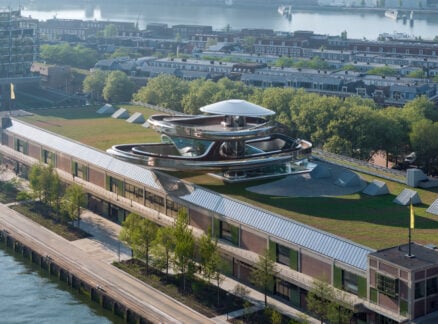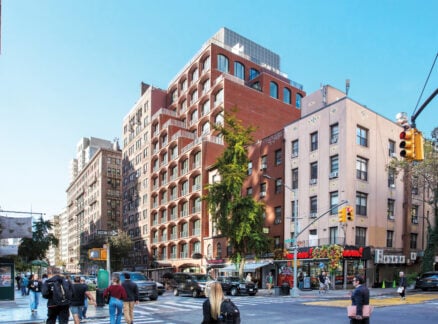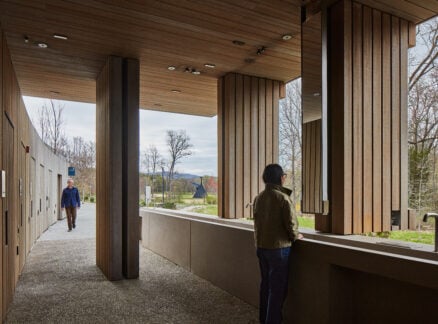December 5, 2006
Mixing the Sacred and the Profane
Renzo Piano talks about the New York Times building, future projects, and his procured inspirations.
To the consternation of some critics like Nicolai Ouroussoff, Renzo Piano has become the go-to architect for American cultural institutions—the default choice when more “adventurous” designers flame out, bust the budget, or spook timid museum boards. And while he did indeed inherit faltering projects once attached to other big names (most notably, The Whitney Museum and LACMA, with Rem Koolhaas), Piano’s credentials are indisputable: thirty-plus years designing some of the world’s most important buildings, a precise and rigorous (and construction-friendly) aesthetic, an urbane and utterly charming personality likely to put even the most skittish directors and donors at ease.
Recently executive editor Martin C. Pedersen spoke to the Genoa, Italy and Paris-based architect in New York about visiting nearly complete buildings, 21st century campus planning, and his voracious method of inspiration. (The interview occurred before the Whitney Museum announced they were canceling plans for their Madison Avenue expansion and exploring sites downtown, including the High Line.)
**
You just came back from touring the New York Times building, which will be completed next year. At this stage, what kind of things are you looking at?
It’s very emotional because you spend years designing a piece and you simulate everything. You make models, prototypes, but one thing you will never simulate is truth, reality. This is only possible when the building is up, because buildings are about scale and presence. It’s one of the reasons why architecture is a cultural pursuit but not the same as art or sculpture. There is a sculptural quality about architecture, but it’s not sculpture because architecture takes place in cities where presence is crucial. In some way, this is a special moment when your dreams become reality and you begin to discover the atmosphere that is impossible to design. So now it’s more about space, scale and feeling than physical beings.
Because of the façade, the building has really changed character during construction. Do you think the ceramic rods will make the structure appear lighter than a typical 52-story tower?
I think so. When the ceramic goes above the roofline, it will become more readable. The other important thing is the way the building touches the ground. Here we’re trying to do it a completely different way. From 40th Street, you can see 43rd Street. From 8th Avenue, you see it through the entire depth of the building, and from the depths of it you can see the traffic on 8th Avenue. This sense of transparency is part of the story. It’s about the art of telling the story by using form. And the idea that the Times is a building and institution where the relationship with the city is more open, more permeable.
One of your New York projects involves Columbia University’s expansion in Harlem. So you’ve been exposed to our famously contentious public process. What has your experience been?
Our site office is on Martin Luther King Boulevard and Broadway. It’s an old factory where they used to pasteurize milk at the beginning of last century. When I visit there and go out for lunch, I talk Italian to the Spanish lady. I know the neighborhood reverend. So, generally speaking, the level of understanding of the scheme is quite good. Everybody’s very keen about making it a good one. We are concerned about making a new complex where the university is not separated from the community. It’s not the same kind of campus they designed a hundred and fifty years ago. It’s a different story today.
You can’t have a campus on a hill—the way the existing campus, as beautiful as it is, is closed off from the community.
Today it is more about dialogue, more about reciprocal enjoyment. So we’re making a scheme where there is a kind of public layer on the first and second floors. It is more about those functions. None are purely academic. They are about cultural activity, shops, clinics, new little companies. So it’s a scheme of light and the edge between architecture, human design and social being. Especially because Harlem is a place with a very strong DNA, a strong character, and we love that of course. But in this process it is never so easy because sometimes the common interest must be understood in association with local and specific interests.
Let’s talk about museums. You’ve been doing them for about thirty years now. How has the brief for architects changed since you and Richard Rogers designed the Pompidou?
When we designed Beauborg a long time ago, the museum was a place of dust and antiquity. They were not places of success. I’m not saying that Beauborg changed that, but it was the engine. So in some way, the brief there was to create a place of success.
And by success you mean vibrancy?
Life. The mixing of the sacred and profane. It may sound absurd, but the real risk today is that you do too much of that, losing the intimacy and needs for silence and introspection. I’m not suggesting you reduce the success of museums, I’m saying that when you design them you have to be careful to provide both dimensions. One is more social. It’s about civic life, street life. It’s about the profane. But you also need to preserve the silence and more introverted moments of enjoyment. Enjoying art is a personal matter. It’s made up by contemplation, silence, abstraction. So you should try to combine those things.
You have a few projects that were once major commissions for other architects, and then they became yours. Obviously there’s a comfort level between museum boards and you. What do they see in you that makes them so comfortable?
That’s a good question, but it’s one you should better ask them. As an architect, you have to provide a shelter to enjoy art. And you have to love art. It’s like when you make a concert hall. You must love music. This is the reason why you make the space, to enjoy music—making a space for art is the same thing. You make the shelter, the envelope, in which art may be seen beautifully. It is not true that to make a good space for art, you make it neutral. Neutral is a dirty, dirty word—it is a terrible thing. Museums are always different. Some are about the collection, some are not. It’s a complex thing, but maybe the constant element is to love art and to put it first. But I don’t want to say too much on that because it may sound a bit moralistic.
When you visit buildings by other architects, what do you look for?
Haha! First, I enjoy them very much. Second, I steal everything. Stealing is maybe too hard a word. There’s an Italian word, you say “rubarro,” which means a nice robber, without a mask.
What did T.S. Elliot say, “Good poets borrow, great poets steal”?
It’s really about that. But art is about that. Music is about taking and giving back. In a way I spend my entire life stealing from everything—from the past, from cities I love, from where I grew up—grabbing things, taking not only from architecture but from Italy, art, writing, poetry, music. And you know what, I put all my robberies in a little piece of paper that I have with me and fill almost a whole sketch pad. Even when I don’t like a building, I still find something to take. This is probably because I was never a good school boy, so I grew up with the idea that I was not the first in class and I was a problem all the time. When you grow up with that idea, you spend your life taking from others.





